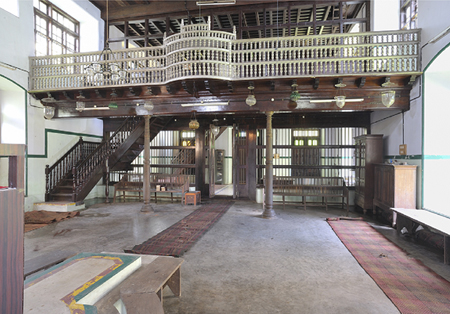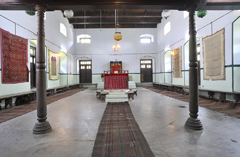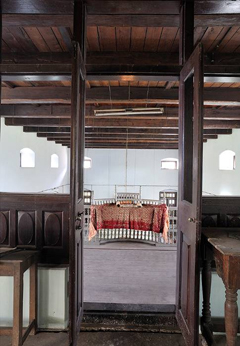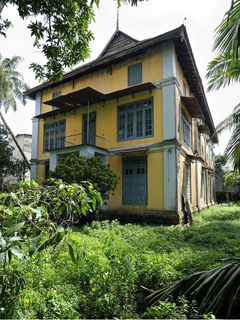Tekkumbagam Synagogue, Ernakulam
By Jay A. Waronker

LOCATION
Kerala’s Malabari Jews have lived in Ernakulam on the mainland of Kochi for centuries. While today there are only a handful of them still residing in this area of the city as a result of the community’s mass immigration to Israel beginning in the mid-1950s, they were once an integral part of Ernakulam. Over the years, the productive and hard-working Malabari Jews pursued a number of professional occupations and trades. Along with fishing and petty trading, many were merchants who ran small private businesses along the narrow and congested streets in the market area, and these shop owners devised their own secret pricing code that incorporated Hebrew. The Jews in Ernakulam for years maintained two synagogues and a religious school.
Today these synagogues, the Kadavumbagam and Tekkumbagam, are no longer functioning, yet they still stand as testament to the area’s once vibrant Jewish presence. They were built in the heart of the market district within a few minutes’ walk of one another. Standing on the north side of Jew Street between Market Road and Broadway and just to the west of a landmark mosque, local tradition relates that the Tekkumbagam Synagogue gets its name from an earlier Jewish house of prayer built in Cranganore. That synagogue was believed to have been located on the southern edge of town – tek referring to south and bagam meaning side in the local Malayalam language.
HISTORY
A Malabari Jewish narrative goes that the Tekkumbagam Synagogue was constructed in 1200 after some of the community, seen as competitors in the lucrative spice industry, were forced out of Cranganore in 1154 by the powerful Moors. They settled in Ernakulam since the Rajah of Cochin offered them friendship and relative protection (Joshua: 1). A sign posted a few decades ago by the Association of Kerala Jews over the entrance to the synagogue property makes claim to this early thirteenth century date. Over the years, the story continues, the synagogue was periodically rebuilt. Another narrative contends that during the time of the brutal Portuguese conquest of Kerala in the mid-sixteenth century, the Jews living in and around Cranganore were persecuted and some perhaps even hung. The Rajah of Cochin, a tolerant and sympathetic man, intervened as best he could to defend the Malabari Jewish community which sought safe haven in Ernakulam. In appreciation, according to this legend, the Jews asked the Rajah what they could do in return for him, and he replied that he wanted a bell. Some of the Jews broke into the Portuguese headquarters at night and stole its large bell. It was brought to the Rajah’s palace in Mattancherry and quietly left outside on its grounds. The next morning, the Rajah woke up to find the bell, and the Jews became known as the “bell thieves.” As a token of his appreciation, the Rajah gave the Jews land for building in the center of Ernakulam. Soon thereafter, a synagogue was built in 1580 (Sassoon: 577).
Whether it was this late sixteenth century building or a later one that was rebuilt on the same site, a small synagogue was replaced in the 1930s to make room for the extant structure. Despite dating to this period of international modern architectural influences, the Tekkumbagam Synagogue was constructed in a traditional way faithful to the local vernacular genre.
The Tekkumbagam Synagogue’s history from the late sixteenth into the modern era may be hazy, but certain things about it are known. A narrative reveals that the synagogue was modeled after the one in Parur, a building that was damaged and rebuilt many times, leaving the specific precedent unclear. One old Malabari Jewish folksong sung by the women of the community in Malayalam focuses on the architecture of Tekkumbagam Synagogue. Although the date of its composition is not known, the architectural details described in the song are of the synagogue that was the immediate predecessor of the current building. The black floors that existed in the old Tekkumbagam Synagogue, for example, were a distinctive feature of traditional Kerala architecture. (Johnson: 45). These floors, used only in special applications such as in rooms of the Rajah of Cochin’s Dutch Palace in Mattancherry, looked like polished black marble, but were a mixture of burned coconut shells, charcoal, lime, sugar cane or other plant juices, and egg whites.
Soft sand once carpeted the outdoor space surrounding the synagogue and framed by property walls. The folksong about the synagogue mentions a decorated threshold of polished granite stone. The hard stone is a significant material in Kerala architecture since it has always been comparatively rare to the region and difficult to quarry. It was thus relegated to key parts of important buildings such as palaces and temples. The granite would be used at the basement to make use of its strength and durability, and on walking and touching surfaces to maintain the highest level of cleanliness. Since purity is a key element of the Hindu religion, the hardness of the granite made these contact areas more resistant to contamination. That granite was used at the threshold of Tekkumbagam Synagogue is also noteworthy since it marked a physical boundary between the contaminated and profane world on the outside with its dirt roads and the more clean and sacred zone within. Although the granite did not continue into the courtyard space of the synagogue, another special material was used. A fine, pure, and prized charol sand taken from the local river bed was spread over the courtyard space, thus creating a distinct sense of place (Johnson: 44; Joshaua, interview by author, Ernakulam Kerala, 2009).
In the mid 1930s, the Kadavumbagam Jewish community decided that the synagogue at that time, in unstable condition and deteriorated, needed to be completely rebuilt, and a larger building was needed. The new sanctuary building as planned was to be the largest of synagogues in Kerala. Some work on the project began in1936 or slightly later, yet construction was halted in 1939 when word of Hitler’s invasions in Europe reached Kochi. There was even concern that the city would be bombed during World War II, and some Jews left Ernakulam temporarily for outlying small communities where fellow Malabari Jews resided. Construction was never resumed in the period that followed, due to social and political changes. A year after Indian Independence in 1947, the State of Israel was established, and Malabari Jews began to leave Kerala for Israel by 1955. With its population in decline, the remaining community determined that there was no need to complete the final phases of the project, which lacked the finished trim work, fabrication of the intended heckal and tebah, certain intended liturgical fittings and furnishings, and an exterior stair to the women’s gallery. Enough of the work had been completed, however, that it could be used by the diminished congregation.
It is possible that the pre-1939 Tekkumbagam Synagogue had a gatehouse and connecting breezeway later were part of a larger compound which included more land to the east. Although today there is a wall to that end of the Tekkumbagam Synagogue’s courtyard, and just beyond is non-synagogue-owned land and buildings, the congregational property may have extended farther originally. The synagogue could have been approached through some type of north-south connecting path linked to the main east-west roads, in a more traditional way via a gatehouse and connecting breezeway. While the exact architectural and planning details of any earlier building configuration – gatehouse, breezeway, and sanctuary – will unlikely be confirmed, this synagogue model had been in place in Kerala for so long that it seems probable that the old Tekkumbagam Synagogue had followed it.
The building currently standing follows the usual pattern for Keralan synagogues: an azara, or anteroom followed by the large double height prayer space on the ground floor, and a balcony with second tebah on the upper level that is adjacent to the women’s seating area placed directed above the azara. Since an intended exterior stair leading up to the women’s seating area was never realized, Tekkumbagam Synagogue has two interior stairways: one from the prayer space to the balcony, and another from the azara to the women’s area directly above
CURRENT STATUS
The Tekkumbagam Synagogue, owned by the Association of Kerala Jews, has been closed as a synagogue for the past decades, although in fairly recent years it served as a gathering hall for community events. Today it stands mostly unused behind locked gates, and access to the building needs to be prearranged through the Association of Kerala Jews. To contact them, speak to the caretaker of the nearby Kadavumbagam Synagogue, Elias “Babu” Josephai.
The yellow building, with some delicate woodwork along its roof lines, is identified by a heritage plaque at the street installed by “The Friends of Kerala Synagogues” in 2009. Once inside the synagogue compound, caution should be taken when walking around the overgrown grounds, which includes a well and second gate and passage opposite the one visitors use
CITED SOURCES
Johnson, Barbara C. and Daniel, Ruby. Ruby of Cochin: An Indian Jewish Woman Remembers. Philadelphia and
Jerusalem: The Jewish Publication Society, 1995.
Joshua, Isaac. The Synagogues of Kerala 70 CE to 1988, unpublished, 1988.
Sassoon, David. Ohel David. Oxford: Oxford University Press, 1932.
Waronker, Jay. Interview of Isaac Joshua, Ernakulam Kerala, 2009.


